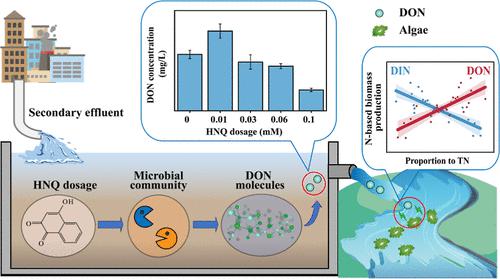当前位置:
X-MOL 学术
›
Environ. Sci. Technol.
›
论文详情
Our official English website, www.x-mol.net, welcomes your feedback! (Note: you will need to create a separate account there.)
2-Hydroxy-1,4-Naphthoquinone: A Promising Redox Mediator for Minimizing Dissolved Organic Nitrogen and Eutrophication Effects of Wastewater Effluent
Environmental Science & Technology ( IF 10.8 ) Pub Date : 2024-01-05 , DOI: 10.1021/acs.est.3c07261 Huazai Cheng 1 , Jiaqian You 1 , Sijia Ma 1 , Kewei Liao 1 , Haidong Hu 1 , Hongqiang Ren 1
Environmental Science & Technology ( IF 10.8 ) Pub Date : 2024-01-05 , DOI: 10.1021/acs.est.3c07261 Huazai Cheng 1 , Jiaqian You 1 , Sijia Ma 1 , Kewei Liao 1 , Haidong Hu 1 , Hongqiang Ren 1
Affiliation

|
Researchers and engineers are committed to finding effective approaches to reduce dissolved organic nitrogen (DON) to meet more stringent effluent total nitrogen limits and minimize effluent eutrophication potential. Here, we provided a promising approach by adding specific doses of 2-hydroxy-1,4-naphthoquinone (HNQ) to postdenitrification bioreactors. This approach of adding a small dosage of 0.03–0.1 mM HNQ effectively reduced the concentrations of DON in the effluent (ANOVA, p < 0.05) by up to 63% reduction of effluent DON with a dosing of 0.1 mM HNQ when compared to the control bioreactors. Notably, an algal bioassay indicated that DON played a dominant role in stimulating phytoplankton growth, thus effluent eutrophication potential in bioreactors using 0.1 mM HNQ dramatically decreased compared to that in control bioreactors. The microbe-DON correlation analysis showed that HNQ dosing modified the microbial community composition to both weaken the production and promote the uptake of labile DON, thus minimizing the effluent DON concentration. The toxic assessment demonstrated the ecological safety of the effluent from the bioreactors using the strategy of HNQ addition. Overall, HNQ is a promising redox mediator to reduce the effluent DON concentration with the purpose of meeting low effluent total nitrogen levels and remarkably minimizing effluent eutrophication effects.
中文翻译:

2-羟基-1,4-萘醌:一种有前途的氧化还原介体,可最大限度地减少废水中溶解有机氮和富营养化的影响
研究人员和工程师致力于寻找减少溶解有机氮 (DON) 的有效方法,以满足更严格的出水总氮限制并最大限度地减少出水富营养化潜力。在这里,我们通过向反硝化后生物反应器中添加特定剂量的 2-羟基-1,4-萘醌 (HNQ) 提供了一种有前景的方法。这种添加小剂量 0.03–0.1 mM HNQ 的方法有效降低了流出物中 DON 的浓度(方差分析,p < 0.05),与对照相比,添加 0.1 mM HNQ 时,流出物 DON 减少高达 63%生物反应器。值得注意的是,藻类生物测定表明,DON 在刺激浮游植物生长方面发挥着主导作用,因此与对照生物反应器相比,使用 0.1 mM HNQ 的生物反应器中的出水富营养化潜力显着降低。微生物-DON 相关性分析表明,HNQ 投加改变了微生物群落组成,既削弱了不稳定 DON 的产生,又促进了不稳定 DON 的吸收,从而最大限度地降低了出水 DON 浓度。毒性评估证明了使用 HNQ 添加策略的生物反应器出水的生态安全性。总体而言,HNQ 是一种很有前景的氧化还原介体,可降低出水 DON 浓度,从而满足较低的出水总氮水平,并显着减少出水富营养化影响。
更新日期:2024-01-05
中文翻译:

2-羟基-1,4-萘醌:一种有前途的氧化还原介体,可最大限度地减少废水中溶解有机氮和富营养化的影响
研究人员和工程师致力于寻找减少溶解有机氮 (DON) 的有效方法,以满足更严格的出水总氮限制并最大限度地减少出水富营养化潜力。在这里,我们通过向反硝化后生物反应器中添加特定剂量的 2-羟基-1,4-萘醌 (HNQ) 提供了一种有前景的方法。这种添加小剂量 0.03–0.1 mM HNQ 的方法有效降低了流出物中 DON 的浓度(方差分析,p < 0.05),与对照相比,添加 0.1 mM HNQ 时,流出物 DON 减少高达 63%生物反应器。值得注意的是,藻类生物测定表明,DON 在刺激浮游植物生长方面发挥着主导作用,因此与对照生物反应器相比,使用 0.1 mM HNQ 的生物反应器中的出水富营养化潜力显着降低。微生物-DON 相关性分析表明,HNQ 投加改变了微生物群落组成,既削弱了不稳定 DON 的产生,又促进了不稳定 DON 的吸收,从而最大限度地降低了出水 DON 浓度。毒性评估证明了使用 HNQ 添加策略的生物反应器出水的生态安全性。总体而言,HNQ 是一种很有前景的氧化还原介体,可降低出水 DON 浓度,从而满足较低的出水总氮水平,并显着减少出水富营养化影响。











































 京公网安备 11010802027423号
京公网安备 11010802027423号